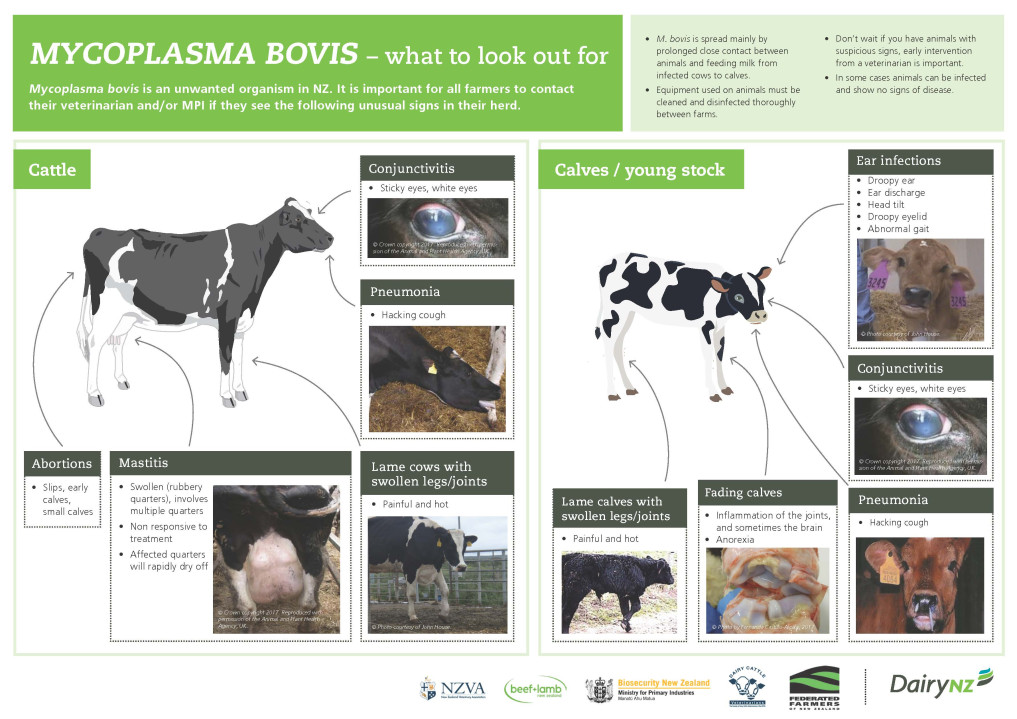M. bovis can cause serious health problems in cattle
Mycoplasma bovis (M. bovis) is a bacterial disease that creates an animal welfare and productivity issue. It can cause serious health conditions in cattle, including mastitis (udder infection), pneumonia, arthritis, and ill-thrift in calves. Less commonly, it can cause progressive neurological disease in calves, conjunctivitis, and reproductive losses.
How M. bovis is spread
Infected animals may shed (release) bacteria in milk, colostrum, nasal secretions, or semen, enabling the bacteria to spread to other cattle. Cattle can be infected with M. bovis without showing any signs of infection.
M. bovis typically spreads between cattle when they have close contact, such as when they:
- mix together in a paddock, pen, milking shed, or calf shed
- walk down a road where nose-to-nose contact is possible with cattle held in paddocks adjacent to the road
- stray across boundaries via break-ins or break-outs
- are calves and are fed milk or colostrum from infected cows.
M. bovis most commonly spreads between properties when M. bovis-infected cattle are introduced into a healthy (previously uninfected) herd.
Infected animals may shed (release) bacteria in milk, colostrum, nasal secretions, or semen, enabling the bacteria to spread to other cattle. Cattle can be infected with M. bovis without showing any signs of infection.
It can also spread via the equipment used on infected cows as part of the milking process.
M. bovis most commonly spreads between properties when M. bovis-infected cattle are introduced into a healthy (previously uninfected) herd.
M. bovis in the environment
M. bovis is fragile in the environment. It only survives for very short times when exposed to heat, drying, and UV light. It can survive longer in cool, moist, and dark environments.
M. bovis is unlikely to survive for long periods in grazing blocks or areas used in baleage and silage production.
The risk of the disease spreading via organic material such as soil, effluent, or feed types (baleage and silage) is also extremely low.
As silage and baleage pose an extremely low risk of spreading M. bovis, they can be confidently used as feed or transferred off the farm for sale.
No risk to food safety, and international trade
The M. bovis bacterium does not pose a risk to human health and it’s safe to eat meat and drink milk from infected cattle.
M. bovis is not considered a disease of relevance to trade by the World Organisation for Animal Health (WOAH) and internationally, there are no regulatory restrictions for meat and dairy products due to M. bovis.Infection is common in many food producing nations, and where infected cattle aren’t showing signs of infection they are processed for human consumption
In New Zealand, our laws mean any animals that are very sick, severely injured or have medications in their bodies are not processed for human consumption. All animals are also examined after slaughter to ensure the meat is safe and suitable for consumption.
Clinical signs of M. bovis

Signs in cattle include:
- unusual mastitis in cows that doesn't respond to treatment
- arthritis
- reproductive losses
- high numbers of calf deaths.
Signs in calves include:
- severe pneumonia, starting as a hacking cough
- arthritis
- ear infections – the first sign typically being one droopy ear, progressing to ear discharges, and in some cases a head tilt and abnormal gait
- conjunctivitis.
Not all infected animals display symptoms, but they can still spread M. bovis to other cattle through close contact.
M. bovis mainly affects cattle and has little effect on other production animals. It does not affect horses and other pets.
Look out for and report any signs of M. bovis to:
- your veterinarian
- MPI on freephone 0800 80 99 66.
Find out more
National Animal Identification and Tracing (NAIT) programme – OSPRI
M. bovis newsletter
Subscribe to get regular updates, news and information sent to your email.







